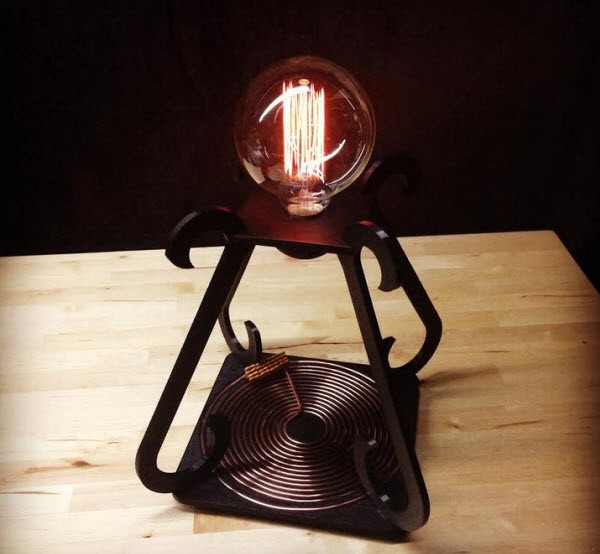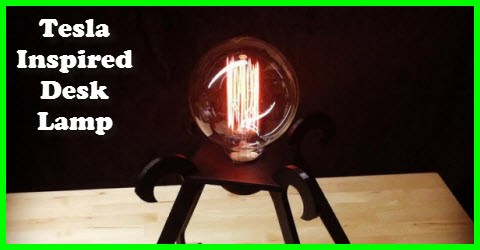This lamp has no power cord going to it.
There is an induction coil in the base which collects te power to light the light bulb.
The light bulb is also inspired by a Tesla designed light bulb.
I came across the article on this 3D printed lamp that has all those Tesla features built in to it.
Here is what they say about it.

“Nikola Tesla’s life and experiments have always intrigued me,” Choi tells 3DPrint.com. “After seeing Tesla Coils light up fluorescent and incandescent bulbs without wires, I was enthralled. I even named my cat Tesla.”
“The design started with the base of the lamp which is the most critical part,” Choi tells us. “It consists of two separate coils that are inductively coupled to each other. One coil is a spiral form and is capacitively loaded and tuned to resonance. The second coil is simply a loop that follows the circumference of the spiral inductor. 3D printing the base made my life incredibly easy. I first performed calculations to create an inductor that would match with my load (the bulb). Then all I had to do was lay the 1/8″ copper tubing into the spiral form. The rest of the lamp, from the legs to the top have no real geometrical features that present itself in the circuit. It was purely aesthetic, including the vintage Tesla commemorative bulb used.”
As for how this lamp works, it sits on a table which has a 6.5MHz, 30W transmitter built into its underside. This center-tapped, double-wind coil is inductively coupled to a much larger loop antenna which has a high Q (quality) factor. This means that it is very efficient when it comes to storing reactive power. The antenna, like the table is tunable and set to a resonance of 6.5MHz.
The receiver is actually the lamp’s base. It includes a spiral-wound, capacitively loaded coil as well as a secondary, single loop coil. The spiral shape creates a flat inductor that can be used for many applications, while the single loop is directly wired to the light bulb itself.
The lamp has four coils which it uses, and the power is inductively transferred through magnetic coupling. The first coil is the primary transmitting coil, and it transmits power to the large secondary receiving coil which stores large amounts of reactive power when it is tuned to resonance. The third coil is the aforementioned spiral-wound coil which is tuned to resonance as well. The fourth coil is the single loop which picks up the fluctuating magnetic field of the third coil, and in turn provides power to the light bulb at 6.5MHz.
You can discover more about this unique design back at the source article.



